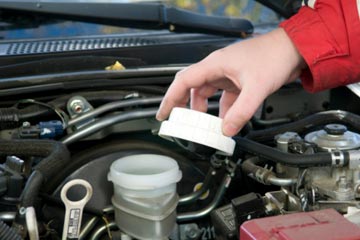What Does the Brake Fluid Level Indicate?

Now comes the fun part. Twist off the fluid reservoir cap, locate the dipstick and wipe it off with a clean, dry rag. Screw it back on, then off, and look at the dipstick. See where the line is between the bottom wet part and the dry part? This line should be somewhere between the "add" and "full" marks. As the brake pads wear down, the brake fluid level will drop slightly. This is natural and is not something to worry about.
Brake fluid is not something that gets consumed, so if it's reading significantly below the "add" mark, then you probably have a leak. If this is the case, get it checked immediately as the brakes are at risk of failure.
Look at the fluid to see if it's dark or clear. Dark fluid indicates significant contamination in the fluid, and you might consider getting your brakes flushed or bled. You can also check the color based on the DOT type (see table on previous page).
If your brakes feel spongy when you depress the pedal, you probably have air in your system. Because air is much more compressible than liquid, the force from your foot won't be delivered efficiently to the brake pad. This alone is a good reason to have your brake system checked.
If your brakes are working properly, and the fluid looks clear and close to the "add" mark, you should add a little brake fluid. Never fill the reservoir above the "full" mark as this could cause damage to your brake system or cause it to overflow. This is bad for two reasons: Brake fluid is extremely corrosive and toxic, and besides eating the paint off your car, it can also lead to blindness and other ailments if it contacts your skin [source: Vaphiades]. Using a latex or similarly protective glove, along with a funnel dedicated solely to this purpose, pour just enough brake fluid into the reservoir to reach slightly below the "full" mark.
Your brake fluid should last 1 to 2 years, but it's in your best interest to check it once a month to make sure the level is adequate and the fluid is clean, especially before a long road trip or if you'll be towing something